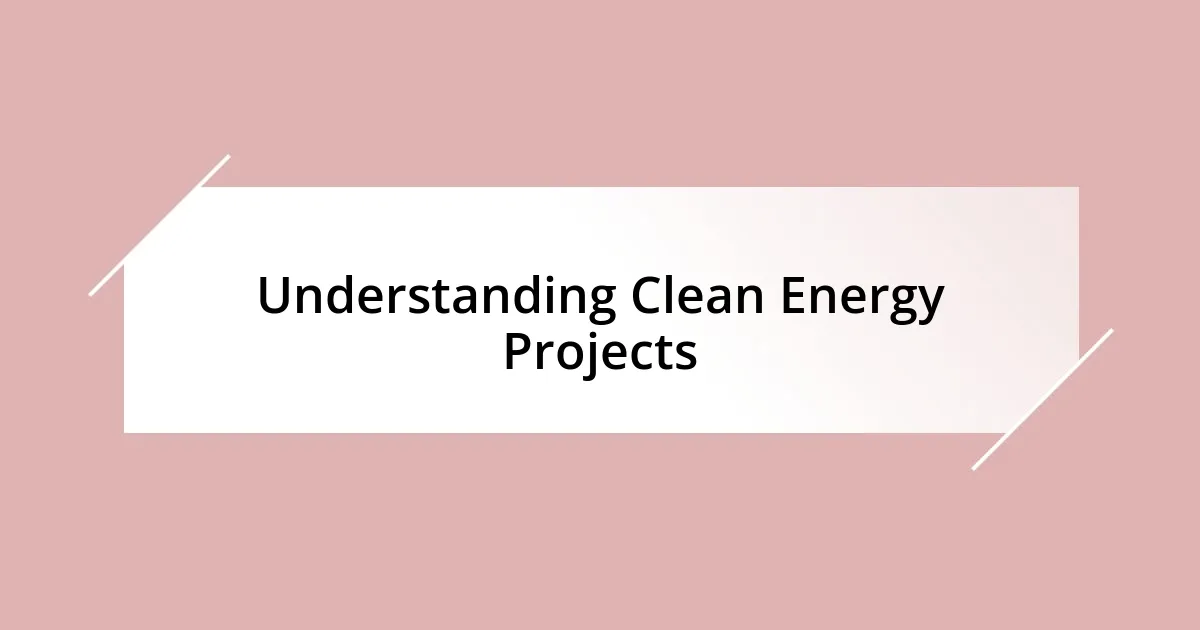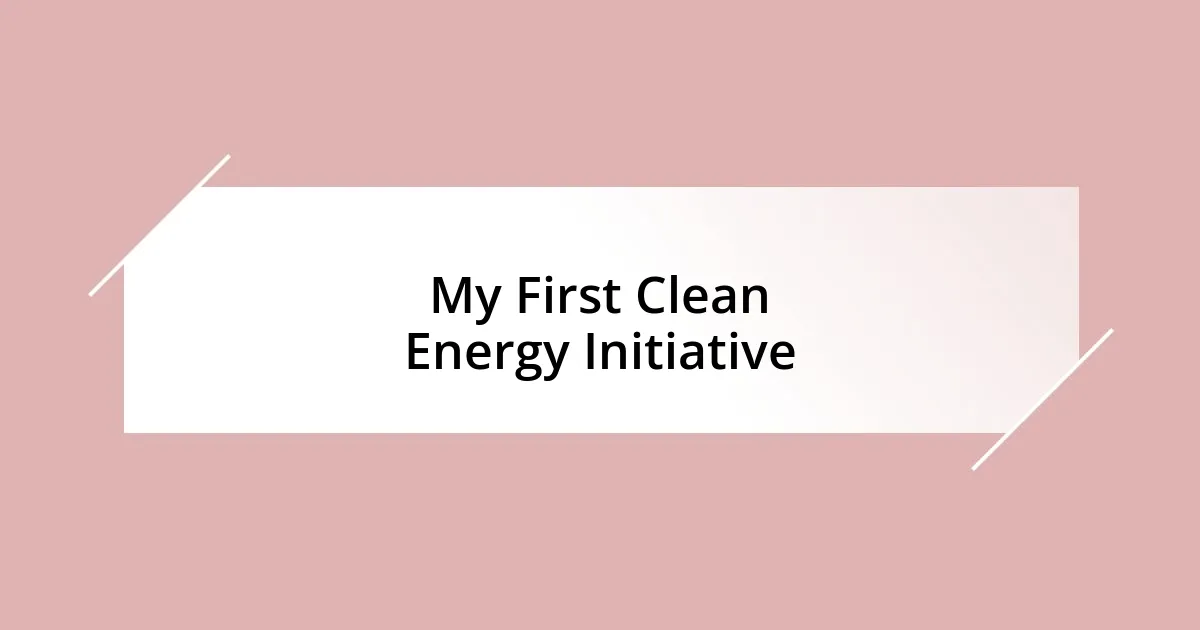Key takeaways:
- Clean energy projects, such as solar and wind initiatives, reduce carbon footprints and promote community empowerment and economic growth.
- Challenges like regulatory hurdles and initial capital costs are significant barriers that need addressing to make clean energy accessible to all.
- Effective project management strategies, including clear communication and stakeholder engagement, are essential for the success of clean energy initiatives.
- The future of clean energy looks promising, with advancements in technology and community-based initiatives poised to transform how we generate and consume energy.

Understanding Clean Energy Projects
Clean energy projects encompass a variety of initiatives aimed at harnessing renewable resources like solar, wind, and hydroelectric power. I remember visiting a solar farm for the first time, and seeing rows of gleaming panels basking in the sun was both awe-inspiring and enlightening. It struck me that these projects not only provide energy but also significantly reduce our carbon footprint, creating a sustainable future.
One of the most compelling aspects of clean energy initiatives is their potential for community involvement. I once participated in a local wind energy project meeting, and the excitement among residents was palpable. Have you ever felt that thrill of being part of something greater? It’s not just about generating electricity; it’s about empowering communities to take control of their energy sources while fostering a sense of shared responsibility for our planet.
Moreover, these projects contribute to technological innovation and job creation. I’ve seen firsthand how a new solar installation can revitalize a struggling area by providing well-paying jobs. Isn’t it remarkable how clean energy can transform economies while protecting the environment? It’s a win-win that resonates deeply with anyone who values sustainable progress.

Benefits of Clean Energy
Clean energy brings numerous benefits that extend beyond just reducing our reliance on fossil fuels. For example, during my time volunteering with a local solar panel installation project, I witnessed how much less energy costs impacted families. Many residents shared stories of how the savings allowed them to invest in other necessities, like education or community activities. It’s a true reminder that clean energy is not just about cleaner air but also about enhancing quality of life.
- Environmental Impact: Clean energy significantly lowers greenhouse gas emissions, aiding in the fight against climate change.
- Economic Growth: These projects can stimulate local economies by creating jobs and attracting investments.
- Energy Independence: By harnessing renewable resources, communities can reduce their dependence on imported fuels.
- Increased Property Values: Homes equipped with clean energy solutions often see an increase in market value, benefiting homeowners.
- Health Benefits: Reduced air pollution translates into fewer health issues, leading to lower healthcare costs.
I vividly recall how one family’s story moved me—a mother explained how the switch to renewable energy not only kept their home comfortable but also allowed her to spend more quality time with her children, rather than working multiple jobs to pay for high utility bills. That sense of freedom and relief was palpable, reinforcing my belief that clean energy is about much more than just power; it’s about empowerment and hope for the future.

My First Clean Energy Initiative
One of my earliest experiences with clean energy began when I joined a college project focused on creating a community garden with solar panels. I can still picture the excitement as we gathered to install everything, not just to grow vegetables but to simultaneously harness solar energy. It felt empowering to be part of a solution that would nourish both the planet and our community.
Later, I remember the day the panels were activated—it was almost ceremonial. Standing there with my peers, we cheered as we illuminated our garden with the sun’s energy. There was a sense of belonging, knowing that our collective efforts could inspire others to think differently about energy and sustainability. It made me reflect on how small initiatives can spark larger movements toward clean energy advocacy.
Reflecting on this experience, I’ve realized that clean energy initiatives are like seeds planted in a garden. They require care and commitment but ultimately yield benefits that extend far beyond their initial impact. The joy I felt from those simple solar panels energizing our garden still resonates with me, reminding me that each project can serve as a catalyst for broader change in our communities.
| Aspect | Experience |
|---|---|
| Project Type | Community garden with solar panels |
| Initial Feelings | Excitement and empowerment |
| Key Outcome | Cultivating both plants and clean energy |
| Catalyst for Change | Inspiration for community sustainability |

Challenges in Clean Energy Implementation
Implementing clean energy projects often feels like a mix of excitement and frustration. I recall one project where we aimed to launch a wind turbine initiative, only to face regulatory hurdles that seemed insurmountable. Navigating permits and compliance became a maze, sometimes leaving me questioning if our efforts were even worth the time and energy. Have you ever hit a wall that made you rethink your goals? I have, and it reminded me that perseverance is a crucial component of success in clean energy.
Another challenge I often encountered was the initial capital investment required. For instance, during a community discussion about solar panels, many residents were enthusiastic but hesitant due to upfront costs. I remember one elderly gentleman expressing his concerns about the financial burden. His worry highlighted a significant barrier—while the long-term savings on energy bills can be substantial, the gap between wanting clean energy and being able to afford it can be daunting. How do we bridge that gap? It’s a question we need to address collectively because the potential benefits are too great to ignore.
On a more personal level, I was part of a stakeholder meeting where community members voiced their skepticism toward clean energy initiatives. Some felt that these projects were more for the affluent, while low-income families struggled with basic energy costs. Listening to their experiences was eye-opening. It brought to light the importance of inclusivity in clean energy discussions. We must ensure that clean energy benefits everyone, not just a select few, as achieving true sustainability requires a united community effort.

Effective Project Management Strategies
Managing clean energy projects effectively is crucial for their success. From my experience, establishing clear communication channels among team members ensures that everyone is on the same page. I once participated in a bi-weekly meeting that transformed our solar initiative. Those touchpoints allowed us to share updates and tackle challenges collaboratively, ultimately making our project stronger.
I’ve found that setting realistic milestones can significantly enhance productivity. In a wind energy project, we broke down long-term goals into smaller, manageable tasks, which helped keep the team motivated. Celebrating each achievement, no matter how small, instilled a sense of progress and renewed our commitment to the cause.
Moreover, stakeholder engagement is non-negotiable. I remember reaching out to a community group early in our planning phase for a solar project. Their insights were invaluable, and involving them in decision-making not only mitigated resistance but also fostered a sense of ownership in the project. Have you ever felt more motivated to contribute when you know your opinion matters? I certainly have, and it reinforced my belief that effective project management hinges on empowering those involved.

Measuring Impact and Success
Measuring the impact and success of clean energy projects isn’t just about numbers or reports—it’s about the real difference we’re making in the community. I remember standing at a local energy fair, and seeing families light up when they learned how much solar panels could reduce their monthly bills. That moment made me realize that success is more than just energy generation; it’s about transforming lives and uplifting communities, creating a shared sense of hope and opportunity.
One method I’ve used to gauge impact is conducting surveys with community members post-implementation. After completing a solar installation, we invited residents to share their experiences. I was surprised by how many expressed not just financial relief but also a newfound sense of environmental stewardship. Have you ever seen a community rally around a common cause? It was awe-inspiring to witness how shared success brought people together, encouraging them to advocate for further clean energy initiatives.
Another critical aspect of measuring success is evaluating the environmental benefits we promised to deliver. During a project aimed at boosting energy efficiency in a local school, we tracked reductions in energy usage over several months. I’ll never forget the pride on the students’ faces when they learned they were part of a larger effort to combat climate change. It reinforced my belief that quantifying success goes hand-in-hand with celebrating the stories behind the numbers. Are we creating positive change? In those moments, I felt unequivocally that we were.

Future of Clean Energy Projects
The future of clean energy projects is incredibly promising, and I believe we’re on the brink of a transformation. I vividly recall attending a conference where a visionary presented cutting-edge solar technology that not only increases efficiency but also integrates seamlessly into existing infrastructure. It was a moment that made me realize how rapidly the industry is evolving, and I found myself asking: how will these advancements shape our communities in the next decade?
As I reflect on the growing trend of community-based clean energy initiatives, I can’t help but feel inspired. I participated in a neighborhood forum where residents discussed collectively investing in solar panels for our community center. The excitement was palpable; everyone understood the potential benefits—not just lower bills, but a stronger, more united community spirit. Who wouldn’t want to be part of that change? Engaging the public in such projects creates not only a sense of ownership but also a tangible way to demonstrate the power of collaborative efforts in tackling climate challenges.
Looking ahead, I’m particularly intrigued by the role of technological innovations, like energy storage solutions. During a recent community workshop, a tech start-up showcased their plans for affordable battery systems to maximize energy efficiency. Just imagining my own home using stored solar energy to power my nights made me wonder: what if every household could become a mini power plant? The possibilities are endless, and I am excited to see how these developments will empower individuals while contributing to a sustainable future.














